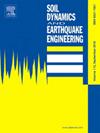Study on the seismic failure mechanism and damage indexes of large-span corrugated steel utility tunnel
IF 4.2
2区 工程技术
Q1 ENGINEERING, GEOLOGICAL
引用次数: 0
Abstract
Large-span corrugated steel utility tunnels are widely used owing to their large spatial spans and excellent mechanical properties. However, under seismic forces, they may experience significant deformation, making repair challenging and posing a serious threat to personal safety. To study the seismic performance of corrugated steel utility tunnels, an equivalent orthotropic plate was introduced, and a simplified three-dimensional refined finite element model was proposed and established. Considering the site conditions of the structure, the structural parameters, and different seismic input conditions, a detailed analysis was conducted using the endurance time analysis method. The results indicated that the simplified model agreed well with the experimental results. The seismic input conditions significantly affected the relative deformation of the structure. Under the action of P waves (compression waves) and P + SV waves (compression and shear waves), the deformation of the upper part of the structure was relatively uniform, whereas under the action of SV waves (shear waves), the deformation of the crown was more evident. The greater the burial depth of the structure, the stronger the soil–structure interaction, and the smaller the increase in relative deformation. In soft soil, the structure was more likely to be damaged and should be carefully observed. Additionally, increasing the corrugation profile of the steel plates during the design process was highly effective in enhancing the overall stiffness of the structure. Based on the above calculation results, the relative deformation rate was proposed as a quantitative index of the seismic performance of the structure, and corresponding values were recommended.
大跨度波纹钢公用隧道地震破坏机理及损伤指标研究
大跨度波纹钢公用隧道因其空间跨度大、力学性能优异而得到广泛应用。然而,在地震作用下,它们可能会发生明显的变形,使维修变得困难,并对人身安全构成严重威胁。为了研究波纹钢公用隧道的抗震性能,引入等效正交各向异性板,提出并建立了简化的三维精细化有限元模型。考虑到结构的场地条件、结构参数以及不同的地震输入条件,采用耐久性时间分析法进行了详细的分析。结果表明,简化模型与实验结果吻合较好。地震输入条件对结构的相对变形有显著影响。在P波(压缩波)和P + SV波(压缩波和剪切波)作用下,结构上部变形相对均匀,而在SV波(剪切波)作用下,冠部变形更为明显。结构埋深越大,土-结构相互作用越强,相对变形增量越小。在软土中,结构更容易受到破坏,应仔细观察。此外,在设计过程中增加钢板的波纹轮廓对提高结构的整体刚度非常有效。根据上述计算结果,提出了相对变形率作为结构抗震性能的定量指标,并推荐了相应的数值。
本文章由计算机程序翻译,如有差异,请以英文原文为准。
求助全文
约1分钟内获得全文
求助全文
来源期刊

Soil Dynamics and Earthquake Engineering
工程技术-地球科学综合
CiteScore
7.50
自引率
15.00%
发文量
446
审稿时长
8 months
期刊介绍:
The journal aims to encourage and enhance the role of mechanics and other disciplines as they relate to earthquake engineering by providing opportunities for the publication of the work of applied mathematicians, engineers and other applied scientists involved in solving problems closely related to the field of earthquake engineering and geotechnical earthquake engineering.
Emphasis is placed on new concepts and techniques, but case histories will also be published if they enhance the presentation and understanding of new technical concepts.
 求助内容:
求助内容: 应助结果提醒方式:
应助结果提醒方式:


